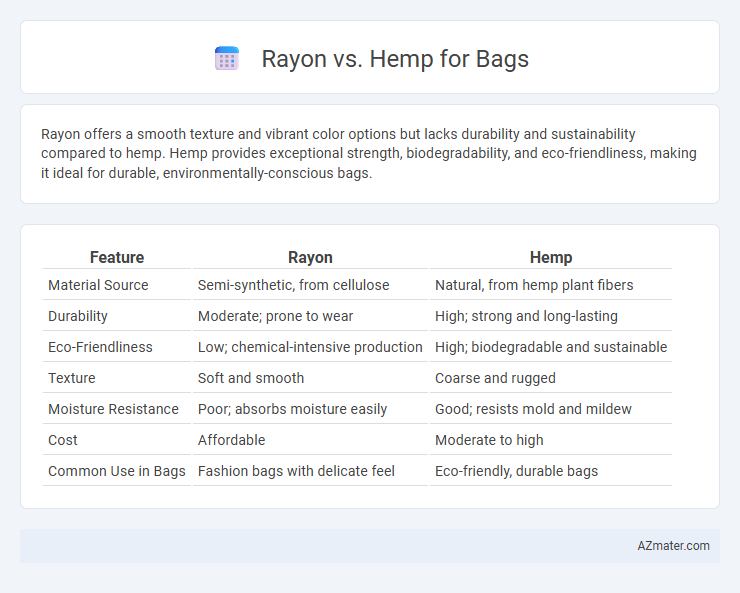Rayon offers a smooth texture and vibrant color options but lacks durability and sustainability compared to hemp. Hemp provides exceptional strength, biodegradability, and eco-friendliness, making it ideal for durable, environmentally-conscious bags.
Table of Comparison
| Feature | Rayon | Hemp |
|---|---|---|
| Material Source | Semi-synthetic, from cellulose | Natural, from hemp plant fibers |
| Durability | Moderate; prone to wear | High; strong and long-lasting |
| Eco-Friendliness | Low; chemical-intensive production | High; biodegradable and sustainable |
| Texture | Soft and smooth | Coarse and rugged |
| Moisture Resistance | Poor; absorbs moisture easily | Good; resists mold and mildew |
| Cost | Affordable | Moderate to high |
| Common Use in Bags | Fashion bags with delicate feel | Eco-friendly, durable bags |
Introduction to Rayon and Hemp Bags
Rayon bags are crafted from regenerated cellulose fibers derived from wood pulp, offering a smooth texture and vibrant color retention ideal for fashion-forward accessories. Hemp bags boast natural durability and eco-friendly qualities, made from the strong fibers of the hemp plant, providing breathability and resistance to wear. Both materials cater to sustainability trends, with hemp emphasizing biodegradability and rayon offering versatility in design and softness.
Material Overview: What is Rayon?
Rayon is a semi-synthetic fiber made from regenerated cellulose, primarily derived from wood pulp, offering a smooth texture and excellent draping qualities. It is highly versatile, commonly used in fashion and home textiles due to its softness and breathability. Unlike hemp, rayon is less durable and more prone to moisture absorption, impacting the longevity of bags crafted from this material.
Material Overview: What is Hemp?
Hemp is a natural fiber derived from the stalks of the Cannabis sativa plant, known for its durability, breathability, and eco-friendly properties. It produces a strong, coarse fabric often used in bags for its high tensile strength and resistance to wear and tear. Unlike rayon, which is chemically processed from cellulose, hemp retains its natural fibers, making it a sustainable and biodegradable material choice for environmentally conscious consumers.
Sustainability: Rayon vs. Hemp
Hemp fibers are highly sustainable, growing rapidly with minimal water, pesticides, or herbicides, making them an eco-friendly choice for bags. In contrast, rayon production involves chemical-intensive processes and significant water usage, contributing to environmental pollution and deforestation. Hemp bags offer greater biodegradability and lower carbon footprint, positioning them as a more sustainable alternative to rayon.
Durability and Strength Comparison
Hemp fibers exhibit superior durability and tensile strength compared to rayon, making hemp bags more resistant to wear and tear over time. Hemp's natural lignin content provides increased resistance to stretching and environmental stress, whereas rayon, being a semi-synthetic fiber derived from wood pulp, tends to weaken when exposed to moisture and friction. Consequently, hemp bags offer enhanced longevity and robustness, ideal for heavy-duty use and sustainable fashion.
Environmental Impact: Rayon vs. Hemp Bags
Hemp bags offer a significantly lower environmental impact compared to rayon bags due to hemp's natural biodegradability and minimal need for pesticides or chemical treatments during cultivation. Rayon production involves intensive chemical processing and high water usage, contributing to pollution and resource depletion. Choosing hemp bags supports sustainable agriculture and reduces pollution, making them an eco-friendly option in comparison to chemically processed rayon alternatives.
Comfort and Aesthetic Appeal
Rayon bags offer a soft, smooth texture that enhances comfort through lightweight, breathable fabric, making them easy to carry during extended use. Hemp bags provide a sturdy, coarse feel with natural fibers that develop a unique patina over time, contributing to a rugged, rustic aesthetic appeal favored in eco-friendly fashion. Both materials balance comfort and style, with rayon leaning towards sleek elegance and hemp emphasizing durability and organic charm.
Cost and Market Availability
Rayon bags generally cost less than hemp bags due to cheaper raw materials and more established production processes, making them widely available in the mass market. Hemp bags, while more expensive, offer durability and eco-friendliness, attracting niche markets focused on sustainability despite limited widespread availability. Market demand for hemp is growing, yet rayon remains dominant in cost-sensitive segments due to its affordability and scalable manufacturing.
Ideal Uses for Rayon and Hemp Bags
Rayon bags are ideal for lightweight, stylish, and affordable everyday use, especially in urban or casual settings due to their smooth texture and vibrant color retention. Hemp bags excel in durability, environmental sustainability, and strength, making them perfect for carrying heavier loads, groceries, or outdoor activities. The choice between rayon and hemp bags depends on whether the priority is aesthetic appeal and softness or eco-friendly toughness and longevity.
Final Verdict: Which is Better for Bags?
Hemp is generally better for bags due to its superior durability, natural resistance to wear, and eco-friendly cultivation requiring less water and pesticides. Rayon offers a softer texture and more vibrant colors but lacks hemp's strength and sustainability benefits. For long-lasting, environmentally conscious bags, hemp remains the preferred material.

Infographic: Rayon vs Hemp for Bag
 azmater.com
azmater.com